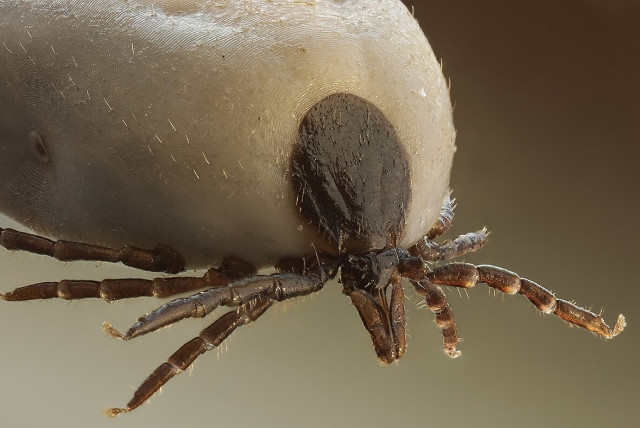Woman saved from life-threatening condition caused by Estonian tick bite

Marina Sogolov was bitten by a tick while in Estonia. After she went home, she was hospitalized and diagnosed with tick-borne encephalitis, a disease that could result in brain damage and death.
A 68-year-old woman from the Galilee who went on a pleasure trip with her husband to Estonia returned with a tick bite that affected her brain and caused encephalitis that threatened her life. Doctors at the Rambam Health Care Campus diagnosed her problem and saved her.
Marina Sogolov from Eshhar in the Galilee south of Karmiel had planned for a long time to go to the Republic of Estonia, a country by the Baltic Sea in Northern Europe, with her 75-year-old husband Mark. The two, who enjoy traveling the world and visiting new places, arrived last July for a period of several weeks so that they could explore and experience as much as possible.
A tick bite that occurred during the trip last month completely disrupted their plans, but miraculously, it ended safely after their return to Israel.
About three weeks after their arrival, Sogolov noticed while she was exercising one morning, a tick attached to her body. She pulled it out and continued her daily routine while monitoring the consequences.
“I'm aware of the dangers, so I was a little worried,” Sogolov recalled, “but I felt well, so we continued the trip. The next day I started to feel weak, and my temperature rose to 38 degrees Celsius – nothing dramatic, but I realized there was a connection.”
Her medical condition remained stable for several days, but it didn’t improve. She contacted a local doctor, who said he was not concerned about her condition. Her illness continued like this for over two weeks, during which she was hospitalized twice for tests at a local hospital and consulted the doctor again, but all of these did not reveal any unusual findings.
Diagnosed with a deadly tick-borne condition
After returning to Israel, Sogolov's condition worsened, when besides the viral symptoms that included fever and weakness, she developed confusion disorientation, and even difficulty speaking normally. She was taken by ambulance to Rambam Health Care Campus in Haifa where the suspicion of encephalitis due to tick-borne encephalitis (TBE) was raised:
“When a person comes to us in such a condition, we can only monitor and provide supportive care,” said Dr. Ami Neuberger, director of the internal medicine-D department and head of the travel-medicine service at the medical center. “It is a viral disease, and we do not have a specific treatment. The range of damage can range from mild symptoms to irreversible brain damage and even death. The course of the disease is often determined by the patient’s physical condition, medical background, and a lot of luck. In this case, our patient was discharged when she was getting better and feeling well again.”
According to Neuberger, although the disease cannot be treated, it can certainly be prevented through vaccination, “In many countries, especially in North America and in Central, Northern and Eastern Europe, this disease is widespread, mostly in rural and wooded areas,” he said. “In Austria, for example, it is customary to vaccinate in childhood against the disease. Travelers who are expected to stay for a long time in such or similar areas are urged to go to a travel-medicine clinic beforehand and consult about the vaccination and other important preparations for the trip. It can save lives.”
Sogolov, who was born in that part of Europe, knew exactly what the doctor was referring to. “I thought of consulting a trave-medicine clinic before the trip, but in the end I didn’t and I regret it. Now I also know the matter first hand. The world and the ecosystems have changed in recent decades. I urge people not to be complacent and to learn from my case. Consult with the experts so you can travel safely.”
TBE is caused by a virus that is transmitted to humans through ticks and the resulting disease affects the central nervous system. It develops in several stages – from an incubation period of about a week, which is characterized by flu-like symptoms, such as high fever, fatigue, and nausea. Later, after a respite of about eight days, in nearly half of the patients, a second phase appears in which various neurological symptoms including behavioral changes, a speech disorder, limb weakness, vision impairment, and more can develop.
Studies have found long-term neurological effects, and in the case of the sub-strain of the virus that is common in Europe, the mortality rate of patients with the disease is one to two percent. There is a much-more- deadly sub-strain common in the Far East with a mortality rate of 30%. There is currently no cure for the virus, but only supportive treatment, depending on the symptoms.
The ticks that transmit the virus, common today in most countries in Western, Central and Eastern Europe, live in forested areas up to an altitude of 1,400 meters and are active from April to November. In some countries like Austria, the vaccine is now given as part of the national vaccination program and has resulted in a significant decrease in the number of TBE patients. In recent years there has been an increase in morbidity, probably due to the phenomenon of global warming and the proliferation of the tick in standing and rivers.
The vaccine is considered very effective and provides more than 90% protection. It is given in three doses – a first dose, a second a month later, and then, between five months and a year later, a booster dose is given that provides protection for three to five years. The vaccine is given to children aged one year and older and is not given to pregnant or lactating women.
Jerusalem Post Store
`; document.getElementById("linkPremium").innerHTML = cont; var divWithLink = document.getElementById("premium-link"); if (divWithLink !== null && divWithLink !== 'undefined') { divWithLink.style.border = "solid 1px #cb0f3e"; divWithLink.style.textAlign = "center"; divWithLink.style.marginBottom = "15px"; divWithLink.style.marginTop = "15px"; divWithLink.style.width = "100%"; divWithLink.style.backgroundColor = "#122952"; divWithLink.style.color = "#ffffff"; divWithLink.style.lineHeight = "1.5"; } } (function (v, i) { });

